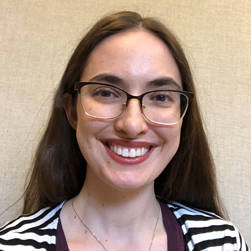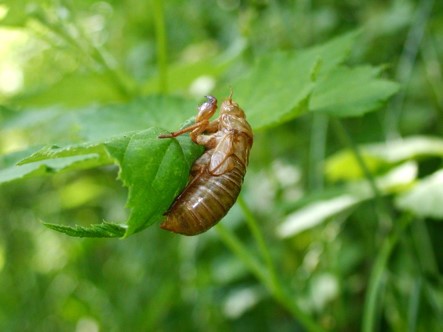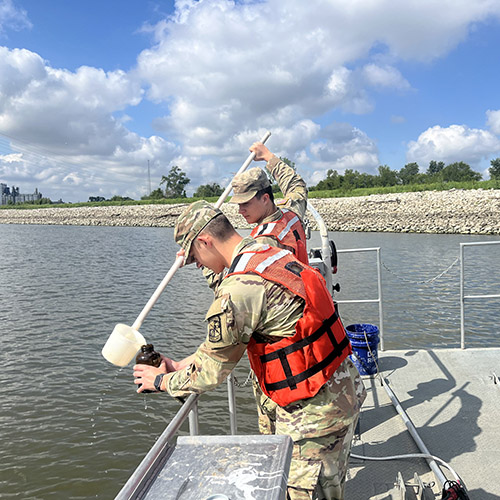Multidisciplinary Cicada Outreach Team Honored by PUCESA
Wendy Mayer, Communications Coordinator
The interdisciplinary team behind The Brood X Cicada Outreach in the spring and summer of 2021 has been selected as the recipient of the Purdue Cooperative Extension Specialists Association (PUCESA) Team Award.
The Team Award recognizes innovative Extension programming by a team of specialists and their allied partners.
 The cicada team, led by exotic forest pest educator Dr. Elizabeth Barnes, created a website, videos, social media posts, citizen science projects and more to educate the public about 17-year cicadas to prevent panic by framing the emergence as a wonder to be enjoyed and not a plague to be endured.
The cicada team, led by exotic forest pest educator Dr. Elizabeth Barnes, created a website, videos, social media posts, citizen science projects and more to educate the public about 17-year cicadas to prevent panic by framing the emergence as a wonder to be enjoyed and not a plague to be endured.
Cicada information ranged from myth-busting - sharing that cicadas do not bite people or cause long-term harm to trees and are not "a plague of locusts,"- to general identification information, tree health, and human and animal health information related to the emergence. In addition, the team produced a poster illustrating cicadas and look-alike insects, shared jewelry and art projects, and even put on a cicada cookie decorating contest in conjunction with the Virtual Bug Bowl event.
"The Cicada Team anticipated the need for solid information for the public well in advance of the emergence of the 17-year periodical cicada," Tom Creswell, Director of the Plant and Pest Diagnostic Laboratory, said in a letter of supporting the team's nomination. "They did an amazing job in creating an engaging and information packed website, complete with identification aids, cicada-related children's activities, fruit tree protection information and offered a newsletter signup for more information. This allowed us to much more easily field questions related to the cicada emergency and allowed us to point to Purdue generated information with confidence in the accuracy."
The team included personnel from the departments of Entomology, Forestry and Natural Resources, and Horticulture and Landscape Architecture as well as Purdue Extension educators, in order to craft specific messaging for nursery crop producers, foresters, fruit producers, landscapers and homeowners.
 The team's website became a source of information for the public and media as well as extension educators across the state, introducing the insect and preventing panic spraying of insecticides or the hiring of contractors selling false promises of protection. The site had nearly 23,000 unique views, while videos deployed by the team on Facebook and YouTube were viewed more than 12,000 times. The related social media campaign reached nearly 85,000 individuals.
The team's website became a source of information for the public and media as well as extension educators across the state, introducing the insect and preventing panic spraying of insecticides or the hiring of contractors selling false promises of protection. The site had nearly 23,000 unique views, while videos deployed by the team on Facebook and YouTube were viewed more than 12,000 times. The related social media campaign reached nearly 85,000 individuals.
More than 30 local and national news outlets ranging from the Indianapolis Star and South Bend Tribune to NBC, CBS, ABC, NPR, Disney Plus and National Geographic picked up on the buzz created by the cicada team. Barnes conducted 47 media interviews herself, while many other local extension educators and specialists also gave interviews to various outlets armed with information from the Cicada website.
Due to its ability to consult with leaders in the tree care industry, the team was able to work with AES (formerly Indianapolis Power and Light), Indy Parks, and the Indiana Arborist Association to distribute information about how to protect newly planted trees during their annual tree give away. In 2021, 1,000 fact sheets were distributed with trees during this one-day event.
The team also developed a system to create and share educational resources to support existing county and campus led programs across multiple departments. This allowed the delivery of information via county level Master Gardener groups, commodity newsletters (Purdue Landscape Report, Indiana Woodland Steward, Facts for Fancy Fruit), as well as activities associated with Entomology's Virtual Bug Bowl, and Forestry and Natural Resources' Ask the Expert program.
"The Team provided valuable resources I could refer to and share, but they also provided very timely responses to my many inquiries directed to them," Brooke Alford, urban agriculture educator for Purdue Extension-Marion County said. "Sarah Bowman, Environmental Reporter for the Indianapolis Star, reached out several times for various articles, and the resources provided by the team allowed Purdue to be the top expert on the topic. Without this team, we would not have been the leading voice on the periodical cicada in Marion County."
The Cicada team consisted of:
Entomology: graduate research assistant Leslie Aviles Lopez; exotic pest educator Elizabeth Barnes; clinical professor Timothy Gibb; assistant professor Laura Ingwell; graduate research assistant Emily Justus; assistant professor Elizabeth Yim Long; outreach coordinator Gwen Pearson; ARGE diversity assistant Eze Pojmann Ezeonyilo; professor and extension fellow Cliff Sadof; web and graphic designer Bransen Shidler
Extension educators: Valerie Clingerman; Phillip Cox; Kenneth Eck; Amy Thompson
FNR: Purdue Extension wildlife specialist Jarred Brooke; Purdue Extension forester Lenny Farlee; communications coordinator Wendy Mayer; urban forester Lindsey Purcell
HLA: organic agriculture specialist Ashley Adair; Purdue Master Gardener State Coordinator John Orick
Resources:
Cicada website
Cicada Activity for Kids
Cicadas and Their Lookalikes Poster
Videos:
Zombie Cicadas
Periodical Cicada Emergence in Tippecanoe County 2004
FNR Ask the Expert: Brood X Emergence
Bug Bowl Cicada Q&A
Cicada Cookies
Origami
Cicada Emergence from 2004
Newsletters:
Facts for Fancy Fruit: Issue 21-01 – Plan ahead to protect young fruit trees from 17-year periodical cicadas emerging in May
Purdue Landscape Report
E-47: Landscape and Ornamental: Periodical Cicada in Indiana
Issue 21-03: 17-Year Cicadas are Coming: Are you ready?
Indiana Woodland Steward – The 17-Year Cicada Emergence is Wrapped Up: Now What?





